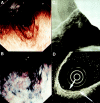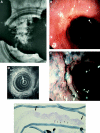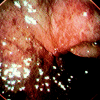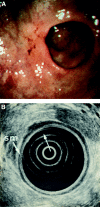The utility of endoscopic ultrasonography and endoscopy in the endoscopic mucosal resection of early gastric cancer
- PMID: 10486372
- PMCID: PMC1727672
- DOI: 10.1136/gut.45.4.599
The utility of endoscopic ultrasonography and endoscopy in the endoscopic mucosal resection of early gastric cancer
Abstract
Objective: To clarify the usefulness of endoscopic ultrasonography (EUS) and endoscopy in the endoscopic mucosal resection (EMR) of early gastric cancer. Patients/Methods-EMR was performed in 61 patients with early gastric cancer over the past five years. The accuracy of the assessment of the depth of cancerous invasion was studied in 49 patients who had EUS before EMR. Forty eight patients were treated with endoscopy alone; in these patients, EUS and endoscopic findings correlated with the clinical course.
Results: Forty six patients showed no changes in the submucosal layer or deeper structures on EUS. Pathologically these included 37 patients with mucosal cancer and nine with submucosal cancer showing very slight submucosal infiltration. Three patients showed diffuse low echo changes in the submucosal layer on EUS; pathologically, these included two with submucosal cancer and one with mucosal cancer with a peptic ulcer scar within the tumour focus. Of 48 patients receiving endoscopic treatment alone, 45 showed no tumour recurrence or evidence of metastases on EUS and endoscopy. Three cases of recurrence were observed. Two of these patients had a surgical gastrectomy, and one was re-treated endoscopically. In the former cases, the surgical results correlated well with assessment by EUS and endoscopy. In addition, the latter patient who was re-treated endoscopically after evaluation with EUS and endoscopy has so far had no recurrence.
Conclusion: The combined use of EUS and endoscopy is effective in diagnosing the depth of cancerous invasion in patients undergoing EMR as well as in clarifying changes both within and between anatomic levels during follow up.
Figures









Similar articles
-
[The utility of endoscopic ultrasonography (EUS) in endoscopic mucosal resection of early gastric cancer].Nihon Shokakibyo Gakkai Zasshi. 1993 Nov;90(11):2866-72. Nihon Shokakibyo Gakkai Zasshi. 1993. PMID: 8271458 Japanese.
-
Morphologic pattern analysis of submucosal deformities identified by endoscopic ultrasonography for predicting the depth of invasion in early gastric cancer.Surg Endosc. 2019 Jul;33(7):2169-2180. doi: 10.1007/s00464-018-6496-2. Epub 2018 Oct 17. Surg Endosc. 2019. PMID: 30334157
-
Comparison of endoscopic ultrasonography and conventional endoscopy for prediction of depth of tumor invasion in early gastric cancer.Endoscopy. 2010 Sep;42(9):705-13. doi: 10.1055/s-0030-1255617. Epub 2010 Jul 22. Endoscopy. 2010. PMID: 20652857
-
Pretherapeutic evaluation of patients with upper gastrointestinal tract cancer using endoscopic and laparoscopic ultrasonography.Dan Med J. 2012 Dec;59(12):B4568. Dan Med J. 2012. PMID: 23290296 Review.
-
Comparison of endoscopic resection and gastrectomy for the treatment of early gastric cancer: a meta-analysis.Surg Endosc. 2016 Sep;30(9):3673-83. doi: 10.1007/s00464-015-4681-0. Epub 2015 Dec 10. Surg Endosc. 2016. PMID: 26659235 Review.
Cited by
-
Diagnostic accuracy of endoscopic ultrasonography (EUS) for the preoperative locoregional staging of primary gastric cancer.Cochrane Database Syst Rev. 2015 Feb 6;2015(2):CD009944. doi: 10.1002/14651858.CD009944.pub2. Cochrane Database Syst Rev. 2015. PMID: 25914908 Free PMC article.
-
Endoscopic ultrasonography: imaging and beyond.Gut. 2003 Aug;52(8):1220-6. doi: 10.1136/gut.52.8.1220. Gut. 2003. PMID: 12865288 Free PMC article. Review. No abstract available.
-
Endoscopic submucosal dissection of early gastric cancer.J Gastroenterol. 2006 Oct;41(10):929-42. doi: 10.1007/s00535-006-1954-3. Epub 2006 Nov 9. J Gastroenterol. 2006. PMID: 17096062 Review.
-
Endoscopic mucosal resection of early gastric cancer: Experiences in Korea.World J Gastroenterol. 2007 Jul 21;13(27):3657-61. doi: 10.3748/wjg.v13.i27.3657. World J Gastroenterol. 2007. PMID: 17659722 Free PMC article. Review.
-
Accuracy of staging in early oesophageal cancer using high resolution endoscopy and high resolution endosonography: a comparative, prospective, and blinded trial.Gut. 2004 May;53(5):634-40. doi: 10.1136/gut.2003.029421. Gut. 2004. PMID: 15082579 Free PMC article.
References
MeSH terms
LinkOut - more resources
Full Text Sources
Medical
Miscellaneous
